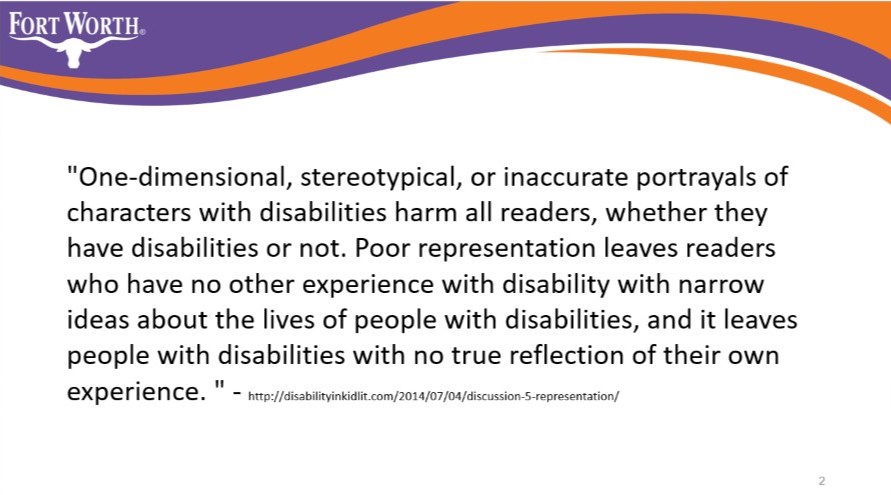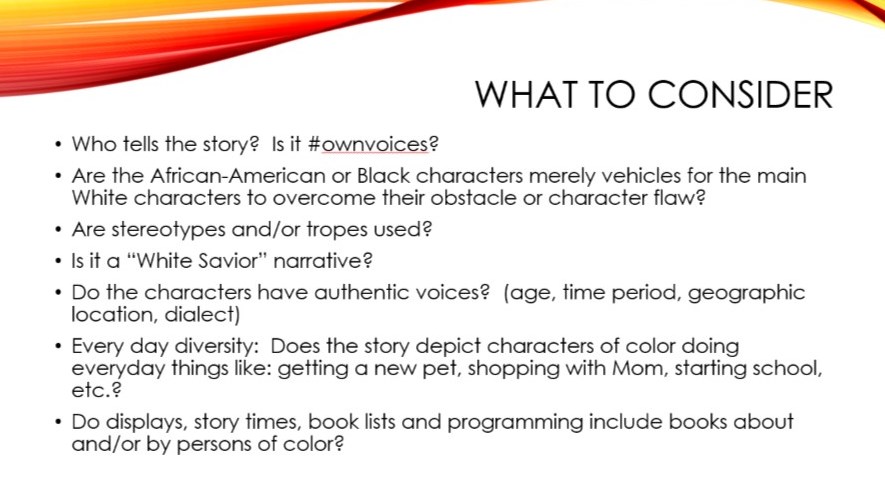Empowering Youth Services Staff to Address Diversity, Equity, and Inclusion in Literature
How Karen Jensen and Kathryn King designed a DEI course for staff at the Fort Worth (TX) Public Library.
In the collection development department at the Fort Worth (TX) Public Library, we devote a lot of time and energy to building collections that are as diverse, equitable, and inclusive as possible. We have many discussions about topics including the Diversity in Children’s Books surveys put out by the Cooperative Children’s Book Center (CCBC), #OwnVoices, and how to create a catalog that will help staff and patrons find diverse materials. These discussions are important, but they are also meaningless if we’re the only people in the system who understand the value of this work. We needed to share this information with all youth services staff, so we began coordinating with the system-wide youth services department to have meaningful discussions with all youth staff about our collections, diversity, and inclusion in collection development, and how staff could use our collections to build displays, create booklists, and incorporate more diversity into our storytimes and programming.

Training goals
Building and maintaining inclusive collections is only one piece of the puzzle for libraries seeking to promote equity and inclusion. What happens if you build an inclusive collection but nobody knows it’s there or how to use it? This question led us to develop diversity, equity, and inclusion (DEI) training throughout our system. Our youth services team already met regularly to promote communication and staff development, and they were kind enough to carve out a half hour from each meeting for DEI training from the collection development department. If your library system doesn’t have such a meeting in place, we highly recommend organizing some type of training; it’s been invaluable to us.
Our main training goal is to empower our youth services staff to be active participants in promoting equity and inclusion in the ways that we use our collections. To that end, we:
• Help our staff better understand the need for a diverse collection by talking about matters of representation (increase communication, empower staff);
• Help our staff better understand the challenges of building a diverse collection by examining existing data (increase communication, empower staff);
• Help our staff develop an in-depth knowledge of our existing collection and diverse titles within that collection (empower staff, increase circulation);
• Give our staff concrete tools to evaluate specific titles and make the most of a diverse collection when serving our patrons (empower staff, increase circulation).
We hope that our staff will put what they’ve learned into practice when discussing the collection with patrons, creating displays or book lists, and pulling books for story times or other programs.
Training guide
So what does this training look like? We spend time between each session researching a topic and preparing the information to share with staff. Each session focuses on a specific topic and follows the same general outline. In 2019 our youth lit training looked like this:
• January: African American representation
• March: Asian American representation
• May: LGBTQ+ representation
• July: Latinx representation
• September: Indigenous and Tribal Nations representation
• November: Disability representation
And each training session is divided into these components:
• Examination of local demographics and CCBC statistics to help staff get a basic understanding of the community and the current state of representation in children’s literature. Many groups are vastly underrepresented, and we all need to make a concerted effort to overcome these deficits by seeking and promoting more diverse titles. Inclusion requires intentionality.
• Discussion of stereotypes and tropes for each specific group so that staff know what to look for and avoid. The goal is to give staff tools to critically evaluate titles for representation. Not all representation is good representation. Many books include harmful stereotypes, and we must be aware of them so we don’t promote titles that harm the youth we serve.
• Discussion of specific titles that have been challenged as harmful. For example, when we did our session on African American representation in youth literature, we shared “The Problem with Picture Book Monkeys,” Edith Campbell’s SLJ article on this racist imagery. Being able to discuss harmful stereotypes and tropes involves research and participation in professional groups where these conversations are happening, including on various social media platforms, blogs, or in professional articles. We also read Dr. Debbie Reese’s “American Indians in Children’s Literature” blog and We Need Diverse Books. Lee & Low Books is another strong resource for discussions of DEI. We also wanted to make sure our staff was aware of discussions of racism in Dr. Seuss.
• Discussion of and list of #OwnVoices authors for that session’s topic. We recommend staff use and promote #OwnVoices titles—works created by authors who share the identity of their characters—whenever possible. It’s important to note, though, that not all authors want to be identified as #OwnVoices. For example, some in the LGBTQ+ community may not be out for their personal reasons. So while the #OwnVoices movement helps lift authors from traditionally under-represented groups in youth literature and to decrease harmful stereotypes, it is not without its challenges.
• Book-talking recommended titles to bring a few titles to the forefront for staff.

So we have the information, but what do we do with It?
We encourage staff to do many things with it. Above all: Look critically and with an eye toward inclusion at every book they use, put on display, or recommend to patrons. Take a step back to really look at a book you’re putting on display. Is it truly inclusive? Is the library promoting titles that members of a community have said are harmful to them? We want to serve the broadest array of patrons and connect them with as many titles as possible to help build empathy, to make sure every kid in our community sees themselves in our collection, and to increase our circulation. It’s a win-win in every way when it comes to helping us meet our goals.
What we’ve learned
When we started our training, there was pushback on some of the controversial titles we discussed. Since Kathryn and I are both white, we keep repeating that we don’t get to tell people from other groups what to think or feel about their representation in works of literature; and we emphasize the need to listen to and respect voices that need to be centered while actively working to decenter the white, Anglo-centric perspective that we have been conditioned to view as the norm. Over time, we have had difficult and necessary conversations, but we’ve also seen language change and sensitivity grow. We’ve seen staff more readily accept those criticisms of individual works or stereotypes, and we’ve seen our staff develop a more nuanced understanding of the idea of representation, why it matters, and how to look at it critically.
In January, for example, we focused on fairy tales, folktales, and myths, to align with the 2020 summer reading theme, Imagine Your Story. Our research led us to discussions about cataloging and how current standards center the Christian perspective. This means that the Christian creation story is placed in the 200s under religion, while Tribal creation stories are placed in the 398s in folklore. We are now talking about moving all creation stories to the 200s. We’ve also discussed ways to include local subject headings that reflect everyday diversity, so that patrons searching for, say, Black History Month titles will find more than slavery and civil rights narratives. All this research has led to discussions that force us to examine bias and find ways to help staff and patrons use the catalog.
We’ve also seen meaningful new interdepartmental relationships and an increased connection between our collections and our programming. Staff will now send us articles to read about a book or the general idea of representation with a little “Hey, have you seen this?” note. Because of the formal training sessions, we are having ongoing conversations in less formal ways.
An additional benefit of this work: It forces us to take a deep dive into the collection and identify our holes, gaps, and biases. Preparation for each training becomes an informal collection diversity audit. When we put together those author and book lists to share with staff, our strengths and deficits become apparent pretty quickly. That information is then used to make purchasing decisions to fill those gaps and beef up specific areas of the collection.
As a collection development librarian, I have found this work to be challenging, positive, and productive. It pushes us as a department to really look at our collection, get outside of our personal and professional comfort zone, and think more systemically about what we are doing behind the scenes to better serve our staff and patrons. I have a richer, deeper knowledge of the literature as a whole and our specific collection. And I have created meaningful relationships with frontline staff so that together, we can better serve our kids. It’s a lot of work, but it’s meaningful, and I think everyone has benefited.

It’s making us better librarians, and people
On a personal note, this project has really just made all of us examine and confront our own biases. For example, Kathryn and I were recently talking about mental health representation in youth literature and the casual use of ableist terms like “crazy.” Learning the correct terminology has been an important and ongoing part of this work. Although I’m sure we both still have a lot to learn—or unlearn, as the case may be—this project has had tremendous positive personal and professional impact on us both, on our library system, and, I believe, on the community we serve.
Resources
Lee & Low Books offers a breakdown of various diversity in publishing and children’s book statistics.
Lee & Low also has a good resource list for finding and evaluating diverse books for quality and representation.
Reflection Press has a look at how many additional books would need to be published by #OwnVoices authors to get equal representation with current demographics.
Teen Librarian Toolbox offers a step-by-step guide to conducting a diversity audit, plus resources.
Dr. Rudine Sims Bishop’s classic article on “Windows, Mirrors, and Sliding Glass Doors.”
Cooperative Children’s Book Center statistics on representation in children’s literature.
Other valuable resources talk about disability representation (Disability in Kidlit) and LGBTQIA+ representation (LGBTQ Reads). A lot of these important discussions happen daily and in real time on places like Twitter and with hashtags such as #disabilityinkidlit, #weneeddiversebooks, #ownvoices, and #representationmatters. Discussions about representation require active participation in ongoing professional development.
Teen Librarian Toolbox founder Karen Jensen is the children's and YA materials selector at the Fort Worth (TX) Public Library (FWPL). Kathryn King has been the collection development manager for the FWPL for seven years. She received her MLS from Texas Woman’s University in 1998 and has worked for libraries in upstate New York, Los Angeles, and Dallas.
RELATED
The job outlook in 2030: Librarians will be in demand
The job outlook in 2030: Librarians will be in demand
ALREADY A SUBSCRIBER? LOG IN
We are currently offering this content for free. Sign up now to activate your personal profile, where you can save articles for future viewing





Add Comment :-
Comment Policy:
Comment should not be empty !!!
Debbie Graham
Great work and thank you for sharing. It would not hurt to add Jewish and Muslim representation. Also could consider South Asian as distinct (not that all these groups don't have unique and disparate subgroups). Also African diaspora would allow for Haitian, Afro-Cuban and the different experiences of Africans in the USA. So many voices, easily another year!
Posted : Sep 16, 2020 05:51